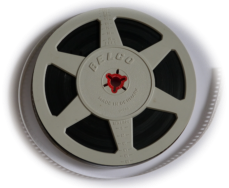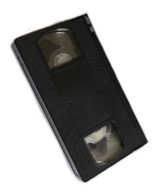

Video Tape problems with ageing
Video tapes are made from an extremely thin ribbon of polyester that is then
coated with magnetic particles. These particles carry the image and sound
information that allow the video to be viewed.
As they age, the polyester can weaken, making a stretch or break of the
tape more likely. The magnetic particles that carry the image can lose
strength over the years - and much more quickly if place near any
source of magnetism.
Another problem seen in some tapes is a whitish covering on the tapes (visible
through the plastic window). This is considered to be mould and can
contaminate a VCR player. Fot that reason we don’t accept such tapes - but
there are specialists around that will provide a cleaning service - at a cost.
There appears to be no consistency in how these tapes have stood the
test of time with some lasting well and others not - even from the same
manufacturer and even when stored together. In our experience, the
majority of tapes have managed to stand the test of time quite well - but
not all. We have seen some tapes where some of the video is partially lost, and
others where the polyester tape itself has become so fragile that it was
impossible to repair.
No tape can be expected to last indefinitely. To keep them at their best for the
longest period, they should always be stored in a cool (not cold) and dry place,
and away from dust. An attic or garage is definitely not ideal!
Cine Film problems with ageing
Cine film is basically a reel of transparent plastic that is covered on one
side with gelatin emulsion. Extremely small light-sensitive silver
halide crystals are embedded onto this emulsion and it these
crystals that form images when a cine camera lens focuses light
on the film as it runs through the camera.
Our experience indicates that the plastic film tends to be made of
stronger materials than video tapes. However, considering the long
path that the film takes through any projector at the rate of 16/18 frames every
second, it does tend to suffer a little physically with every projection. The film is
pulled forward with the projectors teeth in the films sprocket holes and paused
for one sixteenth of a second for the image to be projected before being moved
on again - quite an ordeal! Physical problems that may be present with the film
would be evidence of scratching, burn out and wear/damage to the sprocket
holes.
However, the most common issue we see is that the colour of the emulsion in
some films has faded - and more rarely, the image itself has faded.
As ever, correct storage is as important to cine film as it it to video tapes.






Video Tape problems with
ageing
Video tapes are made from an extremely thin
ribbon of polyester that is then coated with
magnetic particles. These images carry the
image and sound information that allow the
video to be viewed.
As they age, the polyester can weaken,
making a stretch or break of the tape
more likely. The magnetic particles
that carry the image can lose strength
over the years - and much more quickly if place
near any source of magnetism.
Another problem seen in some tapes is a
whitish covering on the tapes (visible through
the plastic window). This is considered to be
mould and can contaminate a VCR player. Fot
that reason we don’t accept such tapes - but
there are specialists around that will provide a
cleaning service - at a cost.
There appears to be no consistency
in how these tapes have stood the
test of time with some lasting well
and others not - even from the same
manufacturer and even when stored together.
In our experience, the majority of tapes have
managed to stand the test of time quite well -
but not all. We have seen some tapes where
some of the video is partially lost, and others
where the polyester tape itself has become so
fragile that it was impossible to repair.
No tape can be expected to last indefinitely. To
keep them at their best for the longest period,
they should always be stored in a cool (not
cold) and dry place, and away from dust. An
attic or garage is definitely not ideal!
Cine Film problems with
ageing
Cine film is basically a reel of
transparent plastic that is covered
on one side with gelatin emulsion.
Extremely small light-sensitive
silver halide crystals are embedded onto this
emulsion and it these crystals that form
images when a cine camera lens focuses light
on the film as it runs through the camera.
Our experience indicates that the plastic film
tends to be made of stronger materials than
video tapes. However, considering the long
path that the film takes through any projector
at the rate of 16/18 frames every second, it
does tend to suffer a little physically with every
projection. The film is pulled forward with the
projectors teeth in the films sprocket holes and
paused for one sixteenth of a second for the
image to be projected before being moved on
again - quite an ordeal! Physical problems that
may be present with the film would be
evidence of scratching, burn out and
wear/damage to the sprocket holes.
However, the most common issue we see is
that the colour of the emulsion in some films
has faded - and more rarely, the image itself
has faded.
As ever, correct storage is as important to cine
film as it it to video tapes.

















